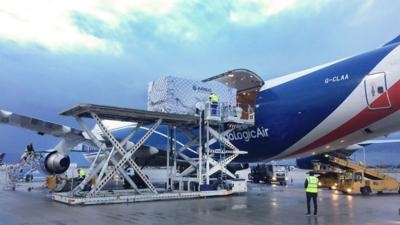Sat, Dec 16, 2017
German-Built Gravity Research Spacecraft Are On The Way To Vandenberg Air Force Base In California
The twin GRACE-FO satellites have begun their journey to Vandenberg Air Force Base in California. Together with test equipment totalling around 50 tons, the gravity research satellites built and developed by Airbus in Friedrichshafen (Germany) were loaded overnight onto an air freighter at Munich airport and flown to the U.S. Tuesday. GRACE-FO is a joint project between NASA’s Jet Propulsion Laboratory (JPL) based in Pasadena, California, and the German Research Center for Geosciences (GFZ) in Potsdam.

Both GRACE-FO research satellites are scheduled for launch in spring 2018, and will be placed in a polar orbit of around 310 miles and with a distance of 136 miles between them. The mission is planned to last at least five years. The satellites will constantly measure the distance between each other to within a few microns using a microwave system built at JPL. At the same time, a sensitive accelerometer, built at Onera in France, will account for non-gravitational effects, such as atmospheric drag and solar radiation.

The data will be used to track the movement of liquid water, ice and land masses by creating monthly maps of the changes in Earth’s gravitational field. GRACE-FO continues this essential climate record established by the predecessor GRACE mission, a joint project between the United States and Germany. GRACE ended its science operations in October after more than 15 years of operations.
The GRACE-FO satellites will also feature a new inter-satellite laser ranging instrument, developed in a German/American joint venture, which will be tested for use in future generations of satellites. In addition, each satellite will record up to 200 profiles per day of temperature distribution and water-vapour content in the atmosphere and the ionosphere to aid weather forecasting.
A team of 15 Airbus space engineers and technicians are currently awaiting the arrival of the satellites in California. The plan is to assemble all test systems on site and check the GRACE-FO spacecraft before the Christmas break in readiness for the launch campaign in 2018.
(Images provided with Airbus news release)
More News
Aero Linx: Commercial Aviation Safety Team (CAST) Founded in 1997, the Commercial Aviation Safety Team (USCAST) has developed an integrated, data-driven strategy to reduce the comm>[...]
Land And Hold Short Operations Operations that include simultaneous takeoffs and landings and/or simultaneous landings when a landing aircraft is able and is instructed by the cont>[...]
We're Everywhere... Thanks To You! Even with the vast resources and incredibly far-reaching scope of the Aero-News Network, every now and then a story that should be reported on sl>[...]
Pilot’s Inadvertent Use Of The Landing Gear Control Handle Instead Of The Flaps Selector Switch During The Landing Rollout Analysis: The pilot reported that during the landin>[...]
Also: Cosmonaut Kicked Out, Airbus Scales Back, AF Silver Star, Russian A-60 Clobbered A Samaritan’s Purse humanitarian flight was hijacked on Tuesday, December 2, while atte>[...]
 ANN's Daily Aero-Linx (12.12.25)
ANN's Daily Aero-Linx (12.12.25) ANN's Daily Aero-Term (12.12.25): Land And Hold Short Operations
ANN's Daily Aero-Term (12.12.25): Land And Hold Short Operations ANN FAQ: How Do I Become A News Spy?
ANN FAQ: How Do I Become A News Spy? NTSB Final Report: Cirrus Design Corp SF50
NTSB Final Report: Cirrus Design Corp SF50 Airborne 12.08.25: Samaritans Purse Hijack, FAA Med Relief, China Rocket Fail
Airborne 12.08.25: Samaritans Purse Hijack, FAA Med Relief, China Rocket Fail




